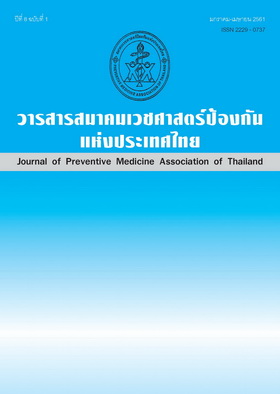Outcome of Palliative Care in Cancer Patients in Maharach hospital, Phra Nakhon Si Ayutthaya Province
Abstract
Cancer is a cause of suffering to patients and family, so palliative care needs across physical, psychological social and spiritual. The purposes of this quasi-experimental research were to compare the results of palliative care service (measurement used palliative care outcome scale: POS) in 32 cancer patients who admitted to Maharach hospital, Phra Nakhon Si Ayutthaya from June to November 2560 (who had palliative performance scale: PPS30%) and cancer patients’/family’s satisfaction of palliative care service. The patients were asked to complete the POS before (during the first day-second day of admission) and after next 3-7 days. Data were analyzed and presented by frequency, percentage, mean and standard deviation. Comparison of outcomes between before and after palliative care used paired t-test with statistical significant level at 0.05. The results showed that the average score of POS after palliative care was decreased with statistical significance (before 28.84, after 17.13, p<0.001). The patients and family’s satisfaction of
palliative care service were high with statistical significance in physical (=3.12, 4.24; p<0.001), social and environment (
=3.08, 4.00; p<0.001) and total palliative care nursing (
=3.00, 4.06; p<0.001). The patients and family’s satisfaction of palliative care service were medium in psychological (
=3.30, 3.50; p<0.001) and spiritual (
=2.40, 3.34; p=0.018). It was concluded that this palliative care can improve patients’ outcomes and satisfaction of service. Therefore, this palliative care system should be generalized to all other settings
References
2. พรปวีณ์ อธิธัญชัยพงษ์. บรรณาธิการ. แนวทางการดูแลผู้ป่วยแบบประคับประคองระยะท้าย. พิมพ์ครั้งที่ 3. กรุงเทพฯ: กรมการแพทย์ กระทรวงสาธารณสุข; 2558.
3. ทัศนีย์ เทศประสิทธิ์, พิมลรัตน์ พิมพ์ดี, ศศิพินทุ์ มงคลไชย, พวงพยอม จุลพันธ์, ยุพยงค์ พุฒธรรม. การพัฒนาระบบการดูแลแบบประคับประคองในผู้ป่วยระยะสุดท้ายของโรงพยาบาลอุดรธานี. วารสารพยาบาลกระทรวงสาธารณสุข 2556;23(1):80-90.
4. โรงพยาบาลมหาราช. รายงานสถิติโรคประจำปี 2559. พระนครศรีอยุธยา: หน่วยงานเวชสถิติโรงพยาบาลมหาราช: 2559.
5. แบบประเมินระดับผู้ป่วยที่ได้รับการดูแลแบบประคับประคองฉบับสวนดอก [อินเตอร์เน็ต]. [เข้าถึงเมื่อ 15 มิถุนายน 2559]. เข้าถึงได้จาก: https://www.med.cmu.ac.th/hospital/nis/ palialive/?Page_id=19
6. ปนัดดา สุวรรณ, ลดารัตน์ สาภินันท์, ธนพัฒน์ ไชยป้อ, ตุลา วงศ์ปาลี, วันทนีย์ แสงวัฒนะรัตน์, เรไร พงศ์สถาพร. ผลลัพธ์การดูแลแบบประคับประคองของผู้ป่วยมะเร็งที่เข้ารับการรักษาในโรงพยาบาลมหาราชนครเชียงใหม่. พยาบาลสาร 2560;44(2):89-103.
7. ศิริเพ็ญ ชั้นประเสริฐ, ทัศนีย์ เชื่อมทอง, สุปราณี ศรีพลาวงษ์. การพัฒนาระบบบริการพยาบาลแบบประคับประคอง กลุ่มการพยาบาลโรงพยาบาลชลบุรี. วารสารศูนย์การศึกษาแพทยศาสตร์คลินิก โรงพยาบาลพระปกเกล้า 2559;33(4):326-39.
8. นพพร ธนามี, สมพร รอดจินดา, วรวรรณ ชำนาญช่าง. ผลลัพธ์การพัฒนาระบบการดูแลผู้ป่วยแบบประคับประคอง. พุทธชินราชเวชสาร 2557;31(2):183-98.
9. ประวีณา ปรีดี. การพัฒนำรูปแบบการดูแลผู้ป่วยโรคมะเร็งระยะสุดท้ายแบบประคับประคองโรงพยาบาลคำม่วง จังหวัดกำฬสินธุ์. วารสารวิจัยและพัฒนาระบบสุขภาพ 2556;6(2):144-19.
Downloads
Published
How to Cite
Issue
Section
License
บทความที่ลงพิมพ์ในวารสารเวชศาสตร์ป้องกันแห่งประเทศไทย ถือเป็นผลงานวิชาการ งานวิจัย วิเคราะห์ วิจารณ์ เป็นความเห็นส่วนตัวของผู้นิพนธ์ กองบรรณาธิการไม่จำเป็นต้องเห็นด้วยเสมอไปและผู้นิพนธ์จะต้องรับผิดชอบต่อบทความของตนเอง






